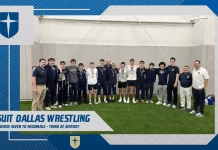 Standing firm, dressed in white and gold in front of the hundreds of berserk Jesuit fans, the Jesuit male cheerleaders play one of the most significant, underlying roles not only in the life of football games but in their own squad too. Along with the video interviews of Senior male cheerleaders Andrew Arbour ’14 and Antonio Gonzalez ’14, current head coach of the Jesuit varsity cheerleading team Ashley Douglas and former head coach Christopher Blackwell also share their experiences with male cheerleaders at Jesuit.
Standing firm, dressed in white and gold in front of the hundreds of berserk Jesuit fans, the Jesuit male cheerleaders play one of the most significant, underlying roles not only in the life of football games but in their own squad too. Along with the video interviews of Senior male cheerleaders Andrew Arbour ’14 and Antonio Gonzalez ’14, current head coach of the Jesuit varsity cheerleading team Ashley Douglas and former head coach Christopher Blackwell also share their experiences with male cheerleaders at Jesuit.
 Male cheerleading at Jesuit has existed from Jesuit’s very beginnings at its first school year in 1942-1943, from a range of 2 to 15 male cheerleaders in the Jesuit varsity cheerleading team, setting a precedent of commitment, responsibility, and school spirit that still lasts until today. Even though the first things that come to mind when one thinks of cheerleaders are girls cheering the rowdy crowd in chants with glittering pom-poms in
Male cheerleading at Jesuit has existed from Jesuit’s very beginnings at its first school year in 1942-1943, from a range of 2 to 15 male cheerleaders in the Jesuit varsity cheerleading team, setting a precedent of commitment, responsibility, and school spirit that still lasts until today. Even though the first things that come to mind when one thinks of cheerleaders are girls cheering the rowdy crowd in chants with glittering pom-poms in their hands, male cheerleaders also play some of the most important and crucial roles within the cheerleading team.
their hands, male cheerleaders also play some of the most important and crucial roles within the cheerleading team.
From personal experience, Mr. Blackwell shares some of the main reasons that he first started cheerleading in 8th grade, high school, and college: ” The most monumental reason I wanted to do cheerleading in high school was so that I could be able to do a back flip.”
Other than wanting to achieve this amazing feat, Mr. Blackwell also says he “wanted to stay physically fit” and “wanted to hang out with attractive females in college. Cheerleading allowed me to do all those things while showing my school spirit. I love everything about cheerleading if there is anything to say about it!”
 Her fourth year coaching cheerleaders, but her first year coaching at Jesuit, Coach Douglas describes the significant, physical parts that male cheerleaders like Mr. Blackwell partake in while cheering out by the football field: “Male cheerleaders are very important parts of cheerleading. Because males are usually physically stronger than girls, it is extremely helpful to have boys on the team so that we can throw more advanced stunts. Male cheerleaders are usually bases (which means they’re on the bottom of the stunts) because they are usually very physically strong, which is needed as a base.”
Her fourth year coaching cheerleaders, but her first year coaching at Jesuit, Coach Douglas describes the significant, physical parts that male cheerleaders like Mr. Blackwell partake in while cheering out by the football field: “Male cheerleaders are very important parts of cheerleading. Because males are usually physically stronger than girls, it is extremely helpful to have boys on the team so that we can throw more advanced stunts. Male cheerleaders are usually bases (which means they’re on the bottom of the stunts) because they are usually very physically strong, which is needed as a base.”
Mr. Blackwell also expresses the physical role of male cheerleaders, explaining that “guys are not typically doing the dance moves; their motions are usually centered from the waist and up.” He also says “one of the main purposes of the male cheerleader is using their voice to encourage the crowd through their megaphones to cheer with them.”
are not typically doing the dance moves; their motions are usually centered from the waist and up.” He also says “one of the main purposes of the male cheerleader is using their voice to encourage the crowd through their megaphones to cheer with them.”
Mr. Blackwell says, “I felt, as a cheerleader, like I had an influence on the outcome of the game by the nature of either encouraging the athletes who were performing well, or by encouraging the crowd to cheer louder so in that way they could increase the spirit of the players.”
 Other than their physical function within the team, male cheerleaders also have more responsibility with the other girls, which is described by Mr. Blackwell: “I enjoyed being able to have awesome relationships with the girls on the team, not that I would be dating as a boyfriend, but I felt that I was a protector of sorts. The girl cheerleaders were easily subjected to catcalls or cheerleader stereotypes, so I felt like it was my job to be the buffer between the crowd and the girls.”
Other than their physical function within the team, male cheerleaders also have more responsibility with the other girls, which is described by Mr. Blackwell: “I enjoyed being able to have awesome relationships with the girls on the team, not that I would be dating as a boyfriend, but I felt that I was a protector of sorts. The girl cheerleaders were easily subjected to catcalls or cheerleader stereotypes, so I felt like it was my job to be the buffer between the crowd and the girls.”
Not only did he experience the responsibility from caring for his fellow cheerleaders, but he also realized that being “able to hold a girl up and recognize that [he] literally had her life in [his] hands took a tremendous amount of trust that [he] exhibited.”
Coach Douglas agrees with Mr. Blackwell’s sense of friendship in the time as she believes that “Boys are an integral part of cheerleading not only because they’re strong, but because they have a certain camaraderie with the teams that they cheer on.”
For this year, there are two senior male cheerleaders on the Jesuit varsity cheerleading team practicing every Monday and Wednesday for two hours each, a team that, according to coach Douglas, is “fortunate to have an excellent, hard-working group of cheerleaders on Jesuit Cheer this year.” Coach Douglas is hoping to increase that number for the years to come.
So if you are currently interested in joining the cheerleading team, Coach Douglas has some encouraging words for you: “Be a cheerleader – it’s the next best thing. You’re on the field or court, actively involved in the game. You get an AWESOME workout from stunting and tumbling during the game. You get to entertain the crowd. And, you get to spend a large majority of your time with cute girls. What more could you want? If you’re strong, we need you!”
The experiences and responsibilities of male cheerleading can truly shape an individual’s future as he grows up. As a testimony to this, Mr. Blackwell says, “And yes, I can still do a backflip.”
Photography courtesy of Jesuit Archives






